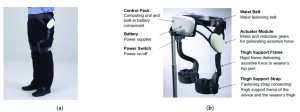Samsung Electronics has developed a wearable advanced robotic aid for older adults which it claims can help boost walking and balance abilities.
EX1 is a hip joint assisted robot primarily designed for exercise to combat the loss of muscle mass in the lower limbs that many people experience as they grow older, but it can be used as a permanent aid too.
Worn on the hip joint, the device has two thigh frames and straps to connect to the subject’s leg. An on-board processor is linked to an inertial measurement unit and to actuators on the frame — allowing it to guide the wearer through exercises.

The EX1 in action
The device operates in two modes, according to Samsung: an ‘assistive mode’, which uses the actuators to enhance the wearer’s movement during exercise and ‘resistive mode’ — actively pushing against the wearer’s movement to provide a tougher exercise.
The hip bot was put to the test by its Korean creators in a four-week trial led by Professor Wan-hee Lee from Sahmyook University College of Health Science, Korea; a collaborative team of researchers, Noble County; and Samsung Electronics.
The team designed an evaluator-blinded, pre-and post-test comparative study comprising of 21 older adults, aged 65 and above. The group performed a supervised exercise program consisting of walking, and strength, and balance exercises, wearing EX1 for 50 minutes per session, three times a week for four weeks.
Tracking the results, the research team found noticeable enhancements, especially during mid-walking, which was attributed to the assistive mode of EX1. This mode notably improved stride length, affecting forward movement in straight walking, according to the research.
While the findings did not find evidence of improved muscle strength over a four-week period, it did find that gait function and balance ability in this population had improved.
“Our findings provide a solid foundation for developing various types of improved and advanced wearable robots,” said Lee.
“This will further expand the global wearable robot market, promoting further research and commercialisation,” he added.
The research team’s work was published in the BMC Geriatrics journal.